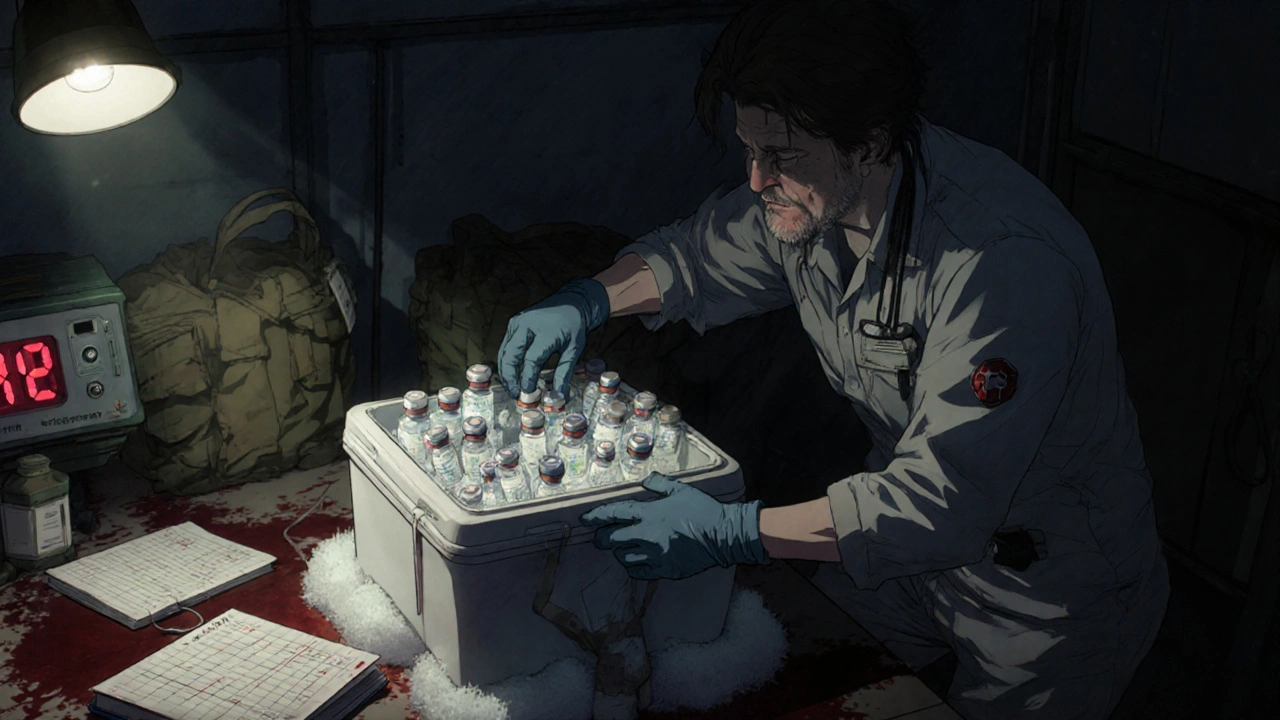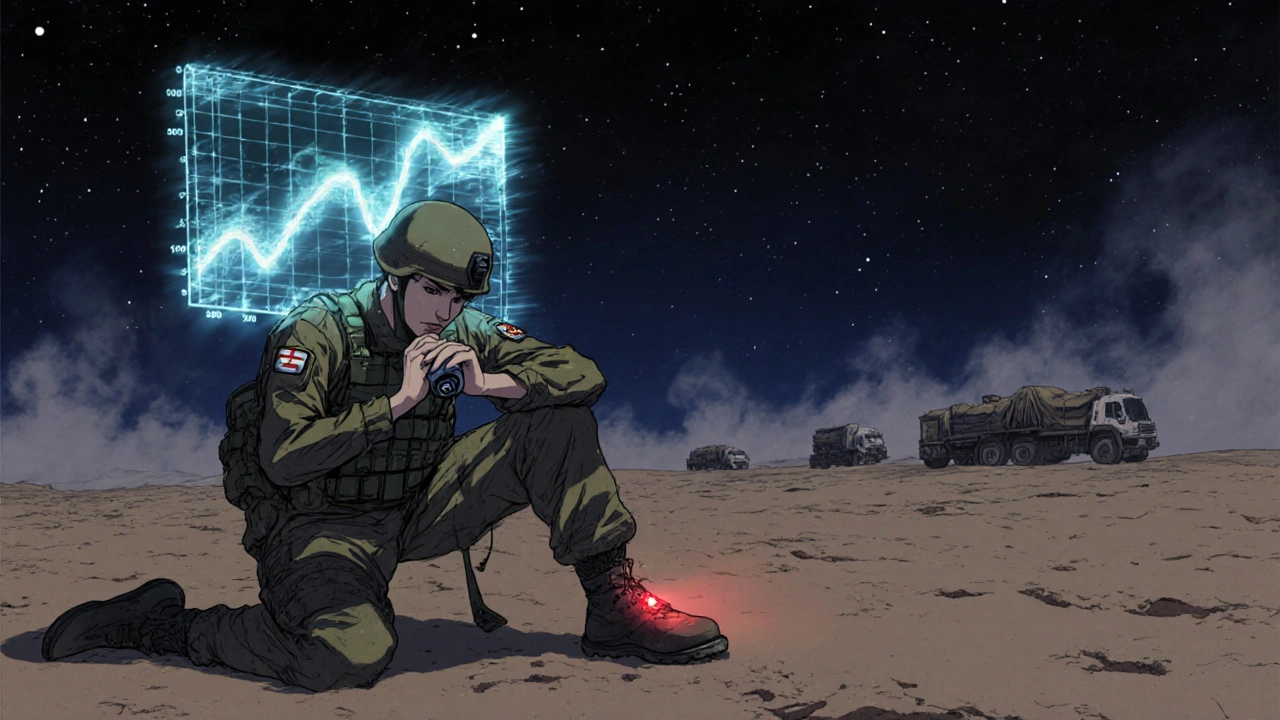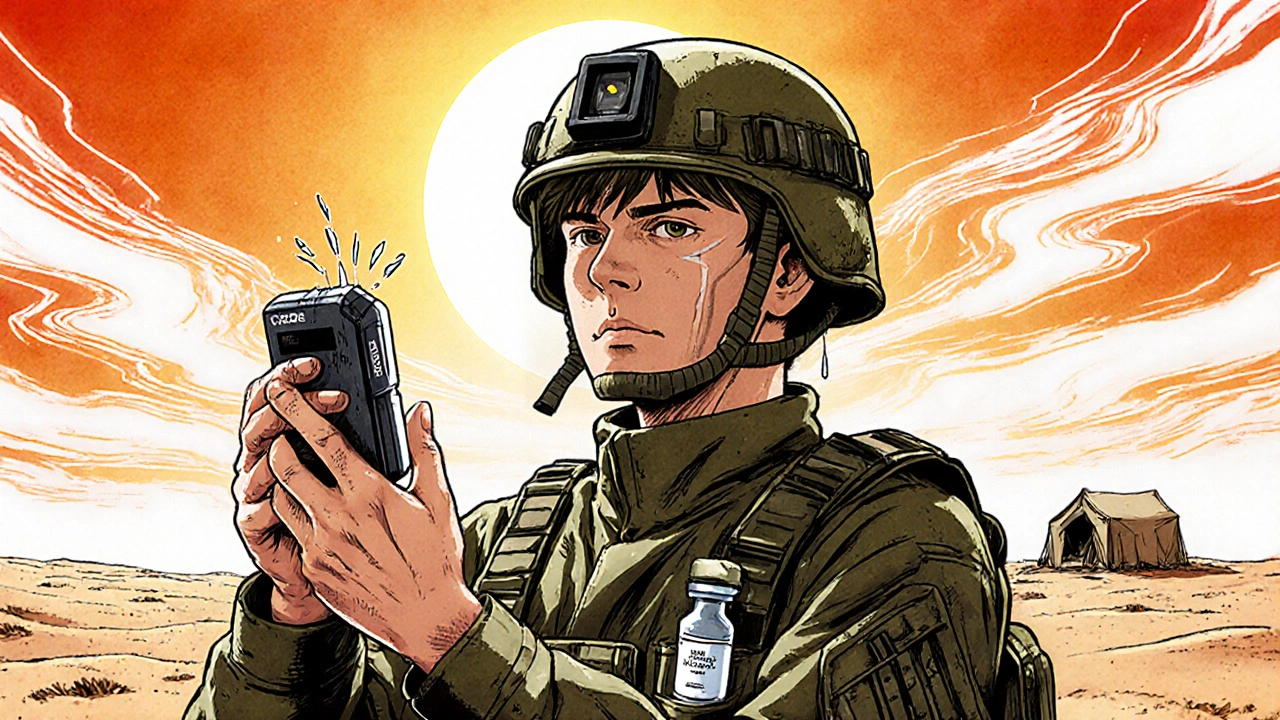Medication Stability Calculator
Deployed Medication Risk Assessment
When a soldier deploys to a desert base where the temperature hits 50°C (122°F), their life-saving medication isn’t sitting safely in a climate-controlled pharmacy. It’s in a backpack, a vehicle, or a tent with no power-exposed to heat that can destroy its effectiveness in minutes. This isn’t hypothetical. In 2023, military medication safety failed in 23% of forward medical units due to temperature excursions. That’s not a glitch. It’s a systemic risk that directly impacts mission readiness and survival.
Why Heat Destroys Medications in the Field
Not all drugs are created equal when it comes to heat. Vaccines for anthrax, rabies, and COVID-19 need to stay between 2°C and 8°C. Antibiotics like doxycycline and insulin can degrade if left above 30°C for more than 48 hours. In the Middle East, where summer temperatures regularly exceed 45°C, that window shrinks to under 12 hours. The U.S. Army Medical Materiel Center-Southwest Asia found that just 30 minutes in direct sun can cut vaccine potency by up to 50%. That means a soldier who gets a weakened shot might not develop immunity at all. Even epinephrine auto-injectors, carried by every soldier for allergic reactions, aren’t immune. Studies show they still work after months at 70°C, but the chemical buffer inside changes. That alters how fast the drug is delivered-meaning the life-saving jolt might come too slow, or too weak. In a combat zone, that delay can be fatal.How the Military Tries to Keep Drugs Cold
The military doesn’t ignore this. It has some of the strictest storage rules in the world. Every refrigerated unit must have two temperature monitors: one digital, one physical. Logs are checked twice a day-morning and evening-no exceptions. All shipments use insulated boxes with gel packs and built-in temperature trackers called ‘Temp-Tale’ devices. These record every bump in heat during transit. If a vaccine hits 10°C for an hour? The whole batch gets flagged. No exceptions. In 2024, CENTCOM stopped paper logs entirely. Now, every TSMP (Temperature-Sensitive Medical Product) shipment has a digital sensor that uploads data in real time. If the temperature spikes, the system alerts a 24/7 response team. That team can dispatch a backup cooler or reroute the shipment within 28 minutes on average. Since switching to digital monitoring in 2022, the military cut medication waste by $2.3 million annually across just one theater.
The Hidden Cost: Time, Labor, and Human Error
All these systems sound perfect-until you talk to the medics on the ground. The reality? They’re drowning in paperwork. Even with digital logs, soldiers still spend 45 minutes every day manually verifying temperatures. That’s 45 minutes they’re not checking wounds, updating patient records, or preparing for the next patrol. A 2024 survey of 327 deployed medics found 57% said this task interfered with their core duties. And it’s not just about time. Generator failures caused 37% of refrigeration breakdowns in 2023. When the power goes out, you’ve got 30 minutes to move all refrigerated meds to a backup unit. If you’re in a remote outpost with no spare fridge? You’re on your own. Some units have improvised solutions-like modifying MRE coolers with phase-change materials to hold 4°C for 12 hours in 45°C heat. One medic on Reddit described taping ice packs to the inside of a metal ammo box lined with foam. It worked. But it shouldn’t have to.Who Gets Left Behind: Access in Combat Zones
Even if the meds survive the heat, getting them to the soldier in time is another battle. The Army Field Manual 4-02 found that in temperatures above 35°C, it takes medics an average of 47 minutes to administer emergency drugs-like epinephrine or antibiotics-compared to just 12 minutes in cooler climates. Why? Because every step takes longer. Gloves sweat off. Gloves stick to vials. IV bags swell. The IV line clogs. The soldier is shaking from heat stress. The medics are exhausted. The clock ticks. And it’s not just frontline medics. Soldiers carrying their own auto-injectors-like those for anaphylaxis or PTSD-related panic attacks-often store them in pockets, vehicle compartments, or even in their boots. No one checks. No one trains them. A 2024 study showed 83% of medication compromises involved insulin or epinephrine because they were stored improperly by the soldier themselves.
What’s Being Done-and What’s Coming
The military is investing heavily to fix this. In April 2025, the Army rolled out AI-powered temperature modeling that predicts where a shipment might overheat before it happens. Initial tests at Fort Bragg cut temperature excursions by 22%. The Defense Advanced Research Projects Agency (DARPA) is spending $28 million on something called StablePharm-medications that can survive up to 65°C. Early results show heat-sensitive antibiotics lasting 40% longer without refrigeration. By 2028, the Army expects 75% of all military pharmaceuticals to have IoT sensors built into the packaging-so you can track a pill’s temperature from the warehouse to the soldier’s hand. That’s a $47 million infrastructure upgrade already complete across all combat commands. But the biggest hurdle isn’t tech-it’s climate. The Middle East had 23 more days above 40°C in 2024 than in 2020. RAND Corporation warns that without major breakthroughs in heat-stable drugs, medication efficacy could drop 15-20% by 2030. That’s not a small risk. It’s a threat to the entire mission.What This Means for Soldiers and Their Families
This isn’t just about cold boxes and digital logs. It’s about whether a soldier survives a snake bite, a heart attack, or an allergic reaction. It’s about whether a unit can deploy without fear of a preventable disease outbreak. It’s about whether a parent knows their child got a vaccine that actually works. The military has the rules. It has the tech. It has the data. But the system still depends on humans-tired, overheated, overworked medics-to make it work. When a soldier’s insulin sits in a hot vehicle for six hours, it’s not a system failure. It’s a human one. And that’s the hardest problem to solve.There’s no app to fix this. No shortcut. No magic pill. Just better training, better gear, and better support. Until then, every soldier carrying a medication into a desert, jungle, or frozen tundra is gambling-not just with their mission-but with their life.
Can military medications be stored in regular refrigerators during deployment?
No. Standard civilian refrigerators aren’t designed for military use. They lack the precision temperature control, backup power, and shock resistance needed in combat zones. Military units use specially designed refrigeration units with NIST-certified thermometers and dual monitoring systems. Even then, they’re often powered by generators that can fail. Portable coolers with phase-change gel packs are used for last-mile transport, but they’re not replacements for proper refrigeration.
What happens if a vaccine is exposed to high heat during transport?
If a vaccine is exposed to temperatures outside its 2°C to 8°C range, its potency can drop by 30-50% within minutes. This means the soldier may not develop immunity, leaving them vulnerable to diseases like anthrax, rabies, or yellow fever. All temperature excursions are logged, investigated, and reported. Affected batches are quarantined and replaced if possible. But if the exposure happened in a forward area with no backup, the soldier may receive a compromised dose with no way to know.
Are there heat-stable versions of vaccines available for deployment?
Yes, but not enough. Since 2020, the Military Vaccine Agency has increased development of heat-stable vaccines by 27%. Some newer formulations for tetanus and meningococcal disease can now survive up to 40°C for weeks. However, most critical vaccines-like those for COVID-19, smallpox, and JEV-still require refrigeration. The DARPA StablePharm program aims to create vaccines stable up to 65°C by 2027, but those aren’t fielded yet.
How do medics know if a medication has been damaged by heat?
They don’t always. Most medications don’t change color, smell, or texture when degraded. The only reliable way to know is through temperature logs. If a ‘Temp-Tale’ device shows the drug was exposed to 40°C for 12 hours, it’s considered compromised-even if it looks fine. In field conditions, medics often have to make judgment calls based on the log, not the appearance of the drug.
What’s the biggest challenge in maintaining medication safety during deployment?
The biggest challenge is the gap between policy and practice. The rules are clear: dual monitoring, digital logs, rapid response. But in the field, generators fail, medics are stretched thin, and temperature checks compete with life-or-death tasks. Technology helps, but it doesn’t replace trained personnel. Without enough staff, proper training, and reliable power, even the best system breaks down.
Is there a difference in how personal medications (like insulin) are handled versus unit-supplied drugs?
Yes. Unit-supplied drugs follow strict cold chain protocols with digital tracking and backup systems. Personal medications-like insulin, epinephrine, or antidepressants carried by soldiers-are often stored in pockets, vehicles, or tents with no oversight. There’s no requirement to log their temperature, no training on proper storage, and no accountability. This is the weakest link in the system. Studies show 83% of medication failures involve these personal drugs.


Gerald Cheruiyot
November 20, 2025 AT 02:49Michael Fessler
November 21, 2025 AT 01:55daniel lopez
November 22, 2025 AT 19:59Nosipho Mbambo
November 24, 2025 AT 18:40Katie Magnus
November 24, 2025 AT 18:40King Over
November 25, 2025 AT 13:45Johannah Lavin
November 26, 2025 AT 12:41Ravinder Singh
November 27, 2025 AT 22:13Russ Bergeman
November 29, 2025 AT 07:39Dana Oralkhan
November 29, 2025 AT 16:27Jeremy Samuel
November 30, 2025 AT 13:58Destiny Annamaria
December 1, 2025 AT 23:40Ron and Gill Day
December 2, 2025 AT 18:43